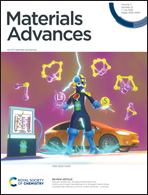A synergistic approach to achieving the high thermoelectric performance of La-doped SnTe using resonance state and partial band convergence†
Abstract
SnTe is an alternate variant of PbTe possessing an analogous valence band (VB) pattern. However, SnTe exhibits low thermoelectric (TE) efficiency due to Sn defects triggering very high carrier concentration (n). Thus, Sn1−xLaxTe, (x = 0.00, 0.04, 0.06, 0.08) was doped with lanthanum (La) to control the vacancy related defects. The TE performance of SnTe was considerably enhanced, where La acts as an electron donor. We propose that La at Sn sites in SnTe creates resonance levels at the VB due to hybridization of the 6s orbital of La and the 5p orbital of Te atom to form the s–p antibonding state, thereby enhancing the Seebeck coefficient and power factor. Besides, due to all-length scale hierarchical architecture, Sn0.94La0.06Te gives ∼96% higher calculated figure-of-merit (zT) than pristine SnTe. The device zT value of Sn0.92La0.08Te is ∼88% higher than that of SnTe. Thus, the significant improvement in device efficiency is encouraging for considering these materials as a suitable alternative to Pb-based chalcogenides.



 Please wait while we load your content...
Please wait while we load your content...